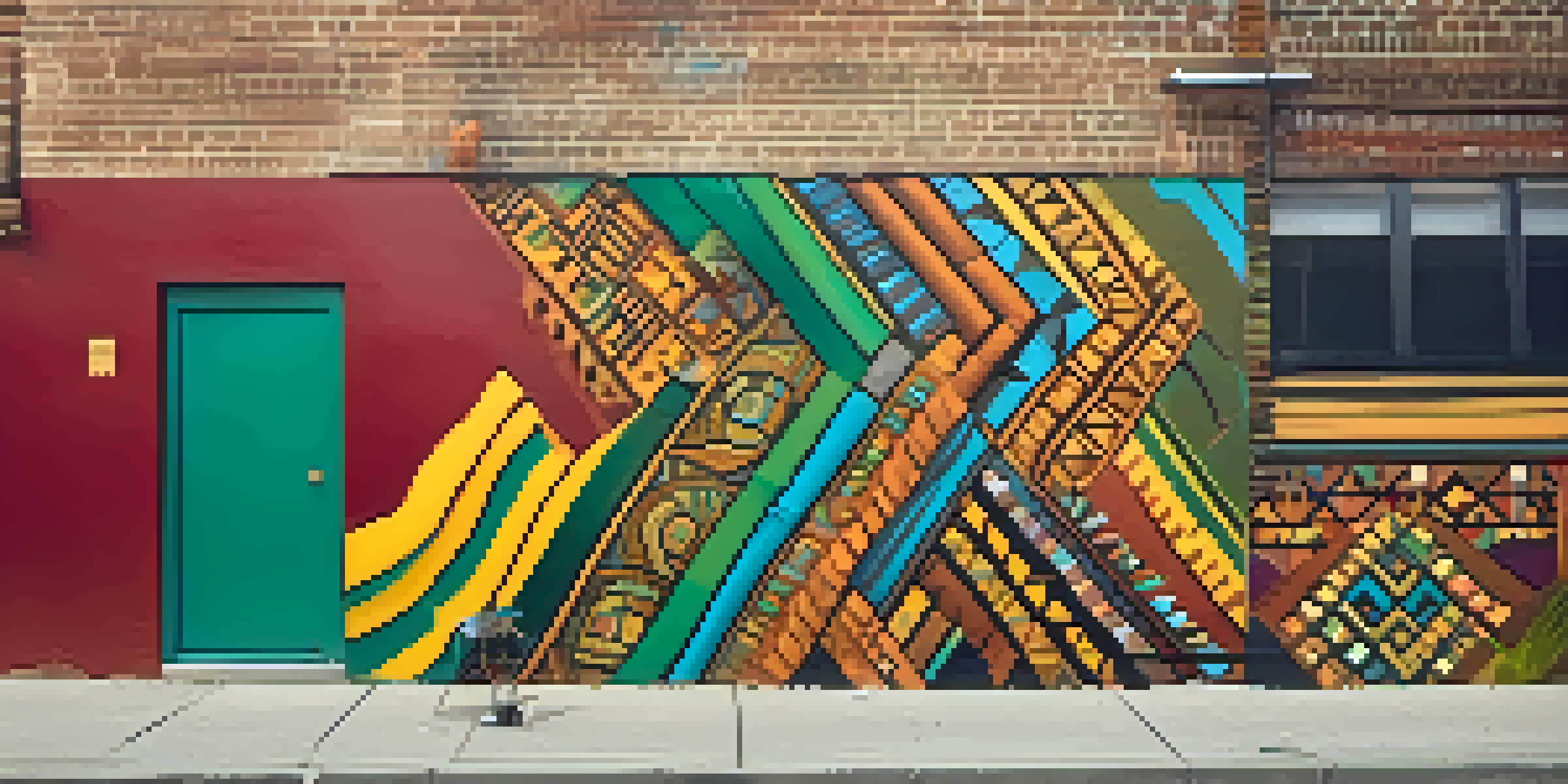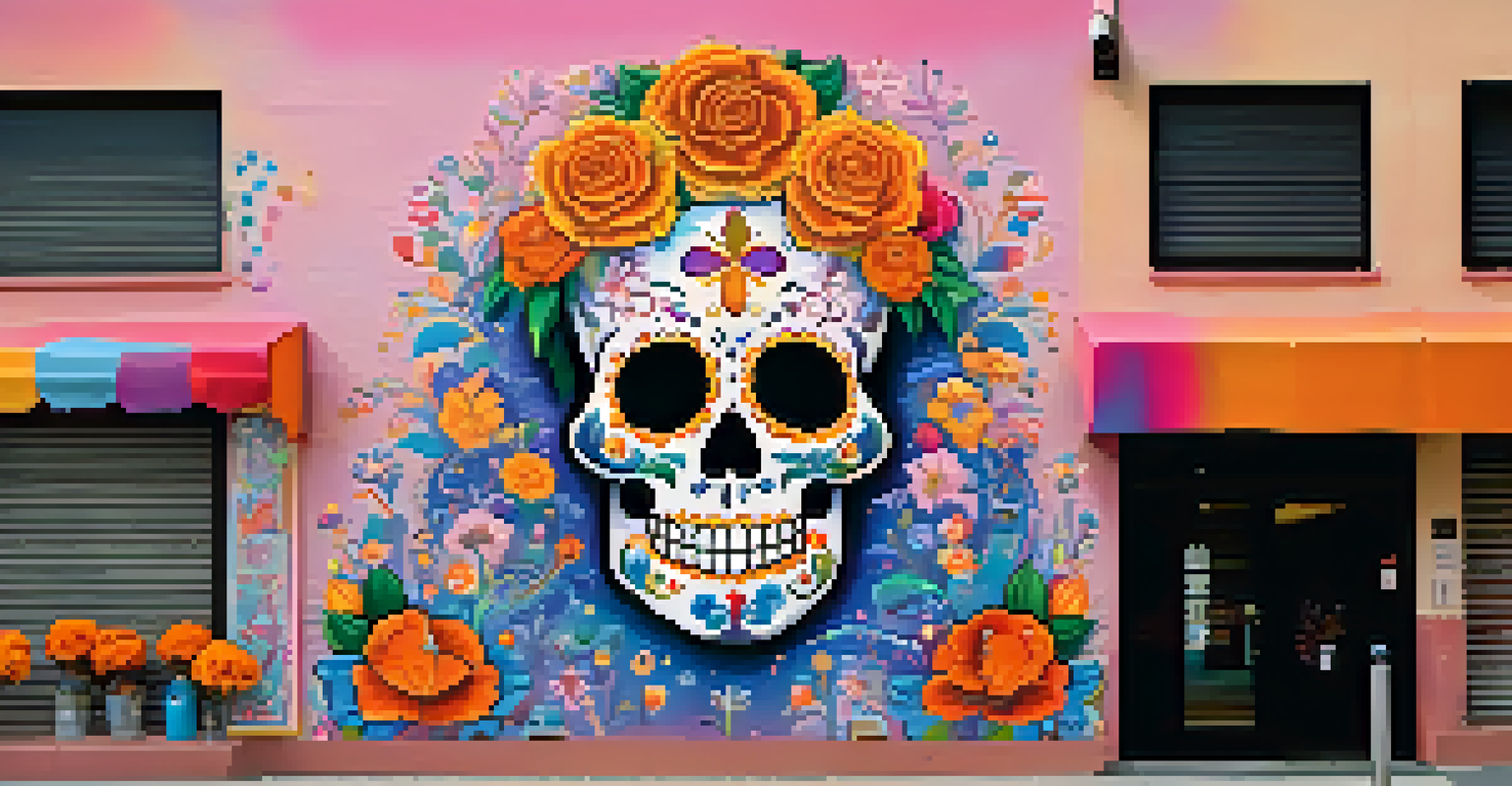Cultural Appropriation in Street Art: A Controversial Topic

Understanding Cultural Appropriation in Art
Cultural appropriation occurs when one culture adopts elements from another, often without permission or understanding. In the realm of street art, this can manifest through the use of symbols, styles, or themes that originate from marginalized cultures. This practice can lead to feelings of exploitation and disrespect, particularly when the appropriating artists benefit commercially from their work.
Art is a reflection of culture, and when we borrow elements from other cultures, we must do so with respect and understanding.
To illustrate, consider a street artist who uses indigenous motifs in their murals without engaging with the community. This can be seen as taking something sacred or significant and using it for personal gain, which raises ethical questions about ownership and respect. Understanding the historical context of these elements is crucial to grasping the full implications of appropriation.
As street art continues to evolve, the lines between inspiration and appropriation can blur. Artists must navigate these complexities with care, acknowledging the origins of their influences and the potential impact of their work on the communities they draw from.
The Fine Line: Inspiration vs. Appropriation
Inspiration is an essential element of creativity, and street art thrives on cultural exchange. However, the challenge arises when inspiration crosses over into appropriation, often leading to controversy. For example, borrowing from a culture's visual language can be enriching, but doing so without context or acknowledgment can be harmful.

Take the case of a street artist who incorporates traditional African patterns into their work. If they celebrate the art form and collaborate with artists from that culture, it creates a dialogue and mutual respect. Conversely, if they simply replicate the patterns for aesthetic purposes without understanding their significance, it can be perceived as appropriative.
Cultural Appropriation Explained
Cultural appropriation occurs when one culture adopts elements from another without permission, often leading to ethical concerns.
Recognizing this balance is essential for artists wishing to engage with diverse cultures. They must ask themselves: Are they amplifying voices or silencing them? This self-reflection can help prevent the pitfalls of appropriation and foster genuine cultural appreciation.
Examples of Controversial Street Art
There have been several high-profile cases in street art that highlight the complexities of cultural appropriation. One notable example is the work of an artist who created murals featuring Mexican Day of the Dead imagery without any connection to the culture. This sparked backlash from the very community whose traditions were being represented.
Cultural appropriation happens when the dominant culture takes from a marginalized culture without acknowledgment or permission.
Critics argued that the artist commodified a sacred celebration, reducing it to mere decoration for a broader audience. Such instances illustrate how disconnected interpretations can erase cultural significance and offend those who hold these traditions dear. This kind of controversy can lead to heated discussions in the art community and beyond.
It's crucial for artists to consider the repercussions of their work. Engaging with the communities they draw inspiration from can not only prevent missteps but also enrich their artistic practice, leading to more authentic and respectful expressions of culture.
The Role of Community in Street Art
Community involvement is vital in addressing issues of cultural appropriation in street art. When artists collaborate with local communities, they create opportunities for dialogue and understanding. This collaboration can lead to more meaningful art that honors the culture while fostering connections between diverse groups.
For instance, community workshops can provide a platform for sharing artistic techniques and cultural narratives. By engaging directly with those from the culture they wish to represent, artists can gain insights that enhance their work. This process not only respects the origins of the art but also empowers the community involved.
Inspiration vs. Appropriation
Artists must navigate the fine line between drawing inspiration from cultures and appropriating their symbols without context.
Building relationships within communities can transform potential appropriation into appreciation. When artists prioritize collaboration over exploitation, the resulting art can serve as a bridge that connects people rather than a barrier that divides them.
The Impact of Social Media on Street Art
Social media has revolutionized the way street art is shared and consumed. While it allows artists to reach wider audiences, it also exposes cultural appropriation issues more readily. Instances of perceived appropriation can quickly gather attention, leading to public debates and discussions on platforms like Instagram and Twitter.
For example, an artist might post a piece that draws from another culture, and followers may call out the lack of credit or understanding. This immediate feedback loop can hold artists accountable, forcing them to consider the implications of their work in real-time. It can also educate audiences on the nuances of cultural representation.
However, this rapid dissemination can sometimes lead to misinterpretations. Artists must navigate the fine line of sharing their work while being receptive to critiques, which can be both a challenge and an opportunity for growth in their artistic journey.
Learning from Cultural Appropriation Discussions
Conversations around cultural appropriation can be uncomfortable yet essential. They challenge artists to reflect on their practices and the societal structures that influence them. Engaging in these discussions can lead to greater awareness and a deeper understanding of the cultures that inspire their work.
For example, an artist may realize that their use of certain symbols stems from a history of colonization or oppression. Acknowledging this history can foster empathy and a desire to engage more responsibly with the cultures they represent. This self-education is a crucial step toward creating art that honors rather than exploits.
Importance of Community Engagement
Collaborating with local communities fosters understanding and respect, transforming potential appropriation into genuine cultural appreciation.
Ultimately, these conversations can contribute to a more inclusive art community. By learning from past mistakes and striving for respectful engagement, artists can move toward a future where cultural appreciation thrives over appropriation.
Moving Forward: Best Practices for Artists
As artists navigate the debate surrounding cultural appropriation, adopting best practices can be instrumental. First and foremost, research is key; understanding the cultural significance behind the elements they wish to use can make a world of difference. This involves not just studying but also listening to voices from those cultures.
Additionally, seeking collaboration can enrich the creative process. By partnering with artists from the cultures they admire, they can create works that reflect a shared vision and mutual respect. This not only honors the source culture but also cultivates a sense of community and understanding.

Lastly, artists should embrace feedback and be open to criticism. Constructive dialogue can lead to growth and innovation in their practice. By committing to these practices, artists can contribute to a more respectful and nuanced street art landscape.